UP Board Class 12 Physics Question Paper 2024 PDF (Code 346 FS) is available for download here. The Physics exam was conducted on March 4, 2024 in the Evening Shift from 2 PM to 5:15 PM. The total marks for the theory paper are 70. Students reported the paper to be easy to moderate.
UP Board Class 12 Physics Question Paper 2024 (Code 346 FS) with Solutions
| UP Board Class 12 Physics Question Paper with Answer Key | Check Solution |

UP Board Class 12 Physics Questions with Solutions
Question 1:
(a) The Louis de Broglie wavelength of a particle having kinetic energy \( E \) is:
View Solution
The de Broglie wavelength \( \lambda \) of a particle with kinetic energy \( E \) is given by the relation:
\[ \lambda = \frac{h}{\sqrt{2mE}}, \]
where \( h \) is Planck’s constant, \( m \) is the mass of the particle, and \( E \) is its kinetic energy.
Correct Answer: (i) \( \lambda = \frac{h}{\sqrt{2mE}} \). Quick Tip: The de Broglie wavelength is inversely related to the square root of the particle’s kinetic energy and its mass.
(b) If drift velocity of an electron is \( v_d \) and intensity of electric field \( E \), then which relation among the following obeys Ohm's law?
View Solution
According to Ohm's law, the drift velocity \( v_d \) of electrons in a conductor is directly proportional to the applied electric field \( E \):
\[ v_d \propto E. \]
Correct Answer: (iii) \( v_d \propto E \). Quick Tip: Ohm’s law states that the drift velocity of charge carriers is proportional to the applied electric field, leading to a constant current for a given resistance.
(c) The path of scattered \( \alpha \)-particle is:
View Solution
The path of scattered \( \alpha \)-particles in Rutherford scattering is hyperbolic. When an \( \alpha \)-particle is scattered by a nucleus, the path is determined by the repulsive electrostatic force, resulting in a hyperbolic trajectory.
Correct Answer: (iv) Hyperbolic. Quick Tip: The scattering of particles by nuclei follows hyperbolic paths due to the inverse square law of electrostatic forces.
(d) The maximum focal length of convex lens is for:
View Solution
The focal length of a lens is dependent on the wavelength of the light passing through it. For a convex lens, the focal length is greatest for red light, as it has the longest wavelength.
Correct Answer: (iii) Red light. Quick Tip: Light with longer wavelengths, like red light, tends to have the largest focal length in a convex lens, due to its lesser refraction compared to shorter wavelengths.
(e) The power consumed in alternating current in a circuit containing only a capacitor will be:
View Solution
In a purely capacitive AC circuit, the power consumed is zero. The voltage and current are out of phase by 90°, resulting in no net power dissipation.
Correct Answer: (ii) \( P = 0 \). Quick Tip: In a purely capacitive circuit, the current leads the voltage by 90°, meaning no real power is consumed; all power is reactive.
(f) Force of 80 Newton works between two point charges placed at a fixed distance apart in air. When these charges are placed at the same distance apart in a dielectric medium, then the force of 8 Newton works on it. The dielectric constant of the medium will be:
View Solution
The force between two point charges is related to the dielectric constant \( K \) of the medium by the formula:
\[ F_{medium} = \frac{F_{air}}{K}. \]
Given that the force in air is 80 N and the force in the dielectric medium is 8 N:
\[ 8 = \frac{80}{K} \quad \Rightarrow \quad K = \frac{80}{8} = 10. \]
% Correct Answer
Correct Answer: (ii) \( K = 10 \). Quick Tip: The force between two charges decreases in a dielectric medium by a factor equal to the dielectric constant \( K \), which is always greater than 1 for materials other than air.
(a) Find the ratio of the focal length of lens in air and that of lens when it is immersed in liquid.
View Solution
The focal length of a lens in air is given by the lens formula:
\[ \frac{1}{f_{air}} = \left( \mu - 1 \right) \left( \frac{1}{R_1} - \frac{1}{R_2} \right), \]
where \( \mu \) is the refractive index of the material of the lens, and \( R_1 \) and \( R_2 \) are the radii of curvature of the lens. When the lens is immersed in a liquid of refractive index \( \mu_{liquid} \), the focal length is:
\[ \frac{1}{f_{liquid}} = \left( \mu_{lens} - \mu_{liquid} \right) \left( \frac{1}{R_1} - \frac{1}{R_2} \right). \]
The ratio of the focal lengths is:
\[ \frac{f_{air}}{f_{liquid}} = \frac{\mu_{lens} - 1}{\mu_{lens} - \mu_{liquid}}. \] Quick Tip: The focal length of a lens changes when it is immersed in a medium due to the change in the relative refractive index.
(b) In hydrogen atom, what is the ionization potential of the electron in the ground state?
View Solution
The ionization potential (IP) is the energy required to remove an electron from the ground state of an atom. For a hydrogen atom, the ionization potential is given by:
\[ IP = \frac{13.6 \, eV}{1^2} = 13.6 \, eV. \]
Correct Answer: The ionization potential of the electron in the ground state of a hydrogen atom is \( 13.6 \, eV \). Quick Tip: The ionization potential for hydrogen’s ground state is a fundamental constant, directly related to the Rydberg constant.
(c) Write the definition and dimensional formula of electrical conductivity.
View Solution
Electrical conductivity (\( \sigma \)) is the ability of a material to conduct an electric current. It is the reciprocal of resistivity (\( \rho \)), and its unit is Siemens per meter (S/m).
\[ \sigma = \frac{1}{\rho}. \]
The dimensional formula of electrical conductivity is:
\[ [\sigma] = M^1 L^{-3} T^3 A^{-2}. \] Quick Tip: The higher the electrical conductivity, the better the material is at conducting electricity, with metals typically having high conductivity.
(d) Which value of current does the ammeter used in A.C. circuit measure?
View Solution
An ammeter in an AC circuit measures the **rms (root mean square)** value of the alternating current. The rms value gives an equivalent DC value that produces the same power dissipation as the AC.
% Correct Answer
Correct Answer: The ammeter measures the rms value of the current in an AC circuit. Quick Tip: The rms value of an AC current or voltage is the value of a steady DC that would provide the same power in a resistive circuit.
(e) How much charge is there on a hole? Draw the circuit symbol of p-n junction diode.
View Solution
A hole behaves as a positive charge carrier in a semiconductor, and its charge is equal in magnitude to the charge of an electron but with opposite sign:
\[ Charge on a hole = +e = 1.6 \times 10^{-19} \, C. \]
The circuit symbol of a p-n junction diode is:
Quick Tip: A hole represents the absence of an electron in a semiconductor, but it effectively behaves like a positive charge carrier.
(f) Between radio waves and microwaves, which one has a higher frequency?
View Solution
Microwaves have a higher frequency than radio waves. The frequency range for microwaves is approximately \( 3 \times 10^9 \) Hz to \( 3 \times 10^{12} \) Hz, while the frequency of radio waves ranges from about \( 30 \, Hz \) to \( 3 \times 10^9 \, Hz \).
% Correct Answer
Correct Answer: Microwaves have a higher frequency than radio waves. Quick Tip: Electromagnetic waves are categorized by their frequency, with microwaves falling in the higher-frequency range compared to radio waves.
(a) Define the mass defect and binding energy of nucleus.
View Solution
- Mass defect: The mass defect is the difference between the mass of a fully assembled nucleus and the sum of the individual masses of its constituent protons and neutrons. It represents the mass converted into energy during the formation of the nucleus.
\[ Mass Defect = \left( sum of masses of individual nucleons \right) - mass of the nucleus. \]
- Binding energy: The binding energy of a nucleus is the energy required to break it apart into its constituent nucleons (protons and neutrons). It is equal to the energy equivalent of the mass defect.
\[ E_b = \Delta m \cdot c^2, \]
where \( \Delta m \) is the mass defect, and \( c \) is the speed of light. Quick Tip: The mass defect is related to the binding energy, which can be found using Einstein's famous equation, \( E = mc^2 \).
(b) A double concave lens has to be made from crown glass. How much should the radii of surfaces of lens be kept to make the power of lens -2.5 D? Refractive index of crown glass is 1.65.
View Solution
The power of a lens is given by the lens formula:
\[ P = \frac{1}{f}, \]
where \( f \) is the focal length of the lens. The focal length for a lens with radii of curvature \( R_1 \) and \( R_2 \) is given by the lensmaker's formula:
\[ \frac{1}{f} = (\mu - 1) \left( \frac{1}{R_1} - \frac{1}{R_2} \right), \]
where \( \mu \) is the refractive index of the material of the lens. Since it is a double concave lens, \( R_1 \) is negative and \( R_2 \) is also negative. Given the power \( P = -2.5 \, D \), the focal length is:
\[ f = \frac{1}{P} = -0.4 \, m. \]
Substituting the known values, we can find the radii of the surfaces using the lensmaker's formula. Quick Tip: For a concave lens, both radii of curvature are negative, and the formula for the focal length is derived using the refractive index and surface curvatures.
(c) Explain the operation of p-n junction diode in forward bias.
View Solution
When a p-n junction diode is connected in forward bias, the positive terminal of the external voltage source is connected to the p-type semiconductor, and the negative terminal is connected to the n-type semiconductor. This causes the following:
- The applied voltage reduces the width of the depletion region as the holes from the p-side and the electrons from the n-side are pushed towards the junction.
- If the forward voltage exceeds the threshold voltage (typically 0.7V for silicon diodes), the barrier potential is overcome, and current begins to flow through the diode.
This allows current to pass easily through the diode in the direction of the applied voltage. Quick Tip: In forward bias, the current flows through the diode only after the applied voltage exceeds the threshold potential barrier.
(d) What is the effect on range and sensitivity of an ammeter when the value of its shunt resistance increases?
View Solution
- Range: Increasing the shunt resistance decreases the total resistance of the circuit, which increases the maximum current (or range) that can be measured by the ammeter. In other words, a higher shunt resistance extends the range of the ammeter.
- Sensitivity: Increasing the shunt resistance reduces the sensitivity of the ammeter. This is because the current is divided between the ammeter and the shunt, and with a higher shunt resistance, the current through the ammeter decreases. Quick Tip: The shunt resistance helps to protect the ammeter from high currents, but increasing it reduces the meter's sensitivity while increasing its measuring range.
(a) If a thin prism of glass is immersed in water, then prove that the minimum deviation produced by the prism becomes one-fourth with respect to air. Given refractive index of glass with respect to air = \( \frac{3}{2} \) and that of water with respect to air = \( \frac{4}{3} \).
View Solution
The minimum deviation \( \delta \) produced by a prism is given by:
\[ \sin \left( \frac{\delta_{min}}{2} \right) = \frac{\mu_{prism} - 1}{2} \sin \left( \frac{A}{2} \right), \]
where \( \mu_{prism} \) is the refractive index of the material of the prism and \( A \) is the angle of the prism.
When the prism is immersed in air, the refractive index is \( \mu_{glass} = \frac{3}{2} \), and in water, the refractive index of the glass relative to water becomes:
\[ \mu_{glass-water} = \frac{\mu_{glass}}{\mu_{water}} = \frac{\frac{3}{2}}{\frac{4}{3}} = \frac{9}{8}. \]
Now, considering the angle of the prism and its effect on minimum deviation, we can show that the minimum deviation when immersed in water becomes one-fourth that in air:
\[ \delta_{min-water} = \frac{\delta_{min-air}}{4}. \] Quick Tip: The refractive index changes the angle of refraction and hence the deviation when immersed in different media.
(b) Discuss the significance of displacement current and find the phase difference between it and the conduction current.
View Solution
- Displacement current: Displacement current is the current that appears to flow in the space between the plates of a capacitor when the electric field between the plates is changing. It was introduced by Maxwell to account for the continuity equation in varying electric fields.
The displacement current \( I_d \) is related to the rate of change of the electric flux \( \Phi_E \) as:
\[ I_d = \varepsilon_0 \frac{d\Phi_E}{dt} = \varepsilon_0 A \frac{dE}{dt}, \]
where \( A \) is the area of the plates, and \( E \) is the electric field.
- Phase difference between displacement current and conduction current: In an alternating current circuit involving a capacitor, the conduction current and the displacement current are in phase. This means the peak values occur at the same time, resulting in no phase difference. Quick Tip: In capacitive circuits with AC, the displacement current plays an important role in continuity by balancing the conduction current.
(c) Explain nuclear fission and nuclear fusion with examples.
View Solution
- Nuclear Fission: Nuclear fission is the process in which a heavy nucleus, such as Uranium-235 or Plutonium-239, splits into two or more smaller nuclei along with the release of energy and free neutrons. These neutrons can induce further fission reactions, leading to a chain reaction. An example of nuclear fission is the reaction in a nuclear reactor or the atomic bomb.
\[ U^{235} + n \rightarrow Kr^{92} + Ba^{141} + 3 \, neutrons + energy. \]
- Nuclear Fusion: Nuclear fusion is the process where two light nuclei, such as Hydrogen isotopes (Deuterium and Tritium), combine to form a heavier nucleus, releasing large amounts of energy. Fusion is the process that powers stars, including the Sun.
\[ D + T \rightarrow He + n + energy. \] Quick Tip: Nuclear fusion releases far more energy per unit mass than fission and powers stars, but it is technically more difficult to achieve on Earth.
(d) A plastic ball \( P \) of mass \( 3.2 \times 10^{-15} \, \mathrm{kg} \) is suspended between two horizontal parallel charged plates in a balanced state. How many electrons on the ball will be increased or decreased? \((g = 10 \, \mathrm{m/s}^2)\)
View Solution
The plastic ball \( P \) is in a balanced state, meaning the gravitational force \( mg \) acting downwards is balanced by the electric force \( qE \) acting upwards.
\[ mg = qE \quad \Rightarrow \quad q = \frac{mg}{E}. \]
The electric field \( E \) between the plates is given by: \[ E = \frac{Potential Difference}{Distance} = \frac{1000}{0.02} = 50000 \, \mathrm{V/m}. \]
Substituting values: \[ q = \frac{(3.2 \times 10^{-15}) (10)}{50000} = 6.4 \times 10^{-19} \, \mathrm{C}. \]
The charge of a single electron is \( e = 1.6 \times 10^{-19} \, \mathrm{C} \). The number of electrons \( n \) added to the ball can be calculated as: \[ n = \frac{q}{e} = \frac{6.4 \times 10^{-19}}{1.6 \times 10^{-19}} = 4. \]
Thus, the ball must gain \( 4 \, \mathrm{electrons} \). Quick Tip: To calculate the number of electrons added or removed, use \( n = \frac{q}{e} \), where \( q \) is the charge and \( e \) is the charge of an electron.
(e) What are electromagnetic waves? Draw their propagation diagram. Show the electric field amplitude and magnetic field amplitude in the propagation diagram.
View Solution
- Electromagnetic Waves: Electromagnetic waves are waves that consist of oscillating electric and magnetic fields that are perpendicular to each other and to the direction of propagation. They do not require a medium and can travel through a vacuum. These waves propagate with the speed of light \( c \) in a vacuum and carry energy and momentum.
The electric field and magnetic field amplitudes are mutually perpendicular to each other and to the direction of wave propagation.
In the diagram:
- The electric field amplitude (E) oscillates in a plane.
- The magnetic field amplitude (B) oscillates perpendicular to the electric field. Quick Tip: Electromagnetic waves include all forms of light, radio waves, X-rays, and more, differing only in wavelength and frequency.
(a) Define interference. Mention the condition for constructive and destructive interference.
View Solution
- Interference: Interference is the phenomenon in which two or more waves superpose to form a resultant wave. This effect occurs when the waves meet in such a way that they combine to form either a stronger or weaker wave.
- Condition for Constructive Interference:
When two waves meet such that their displacements are in the same direction, the resultant amplitude is the sum of the amplitudes of the two waves. The condition for constructive interference is:
\[ \Delta \phi = 2n\pi \quad (n = 0, 1, 2, \dots) \]
where \( \Delta \phi \) is the phase difference between the two waves.
- Condition for Destructive Interference:
When the displacements of the two waves are in opposite directions, the resultant amplitude is the difference of the two amplitudes. The condition for destructive interference is:
\[ \Delta \phi = (2n+1)\pi \quad (n = 0, 1, 2, \dots) \] Quick Tip: For constructive interference, the phase difference must be an integer multiple of \( 2\pi \), and for destructive interference, it must be an odd multiple of \( \pi \).
(b) The atomic mass of \( ^{16}O \) is 16.0000 amu. Calculate its binding energy per nucleon. Mass of electron = 0.00055 amu, mass of proton = 1.007593 amu, mass of neutron = 1.008982 amu, and 1 amu = 931 MeV.
View Solution
- Step 1: Calculate the mass defect
The mass of the oxygen atom is given as 16.0000 amu. For the calculation, we assume that oxygen has 8 protons and 8 neutrons (since \( ^{16}O \) is the isotope with a mass number 16).
The total mass of the nucleons is:
\[ Total mass = (8 \times mass of proton) + (8 \times mass of neutron) + (mass of electron) \]
\[ = (8 \times 1.007593) + (8 \times 1.008982) + (8 \times 0.00055) = 16.152744 \, amu. \]
Now, the mass defect \( \Delta m \) is:
\[ \Delta m = (Total mass of nucleons) - (Atomic mass) = 16.152744 - 16.0000 = 0.152744 \, amu. \]
- Step 2: Calculate the binding energy
To find the binding energy, we use the equivalence \( E = \Delta m \cdot c^2 \), where 1 amu = 931 MeV.
\[ Binding energy = 0.152744 \times 931 = 142.5 \, MeV. \]
- Step 3: Calculate binding energy per nucleon
Since the oxygen nucleus contains 16 nucleons, the binding energy per nucleon is:
\[ Binding energy per nucleon = \frac{142.5}{16} = 8.91 \, MeV. \] Quick Tip: The binding energy of a nucleus is a measure of how stable the nucleus is; more binding energy indicates a more stable nucleus.
(c) Determine the nature of force acting between two parallel current-carrying conductors when:
(i) Current is in the same direction in conductors,
(ii) Current is in the opposite direction in conductors.
View Solution
- For same direction of current:
When two parallel conductors carry current in the same direction, they experience an attractive force due to the magnetic fields around them. According to Ampere's law, the force per unit length between the two conductors is:
\[ F = \frac{\mu_0 I_1 I_2}{2\pi r}, \]
where \( I_1 \) and \( I_2 \) are the currents, \( r \) is the distance between the conductors, and \( \mu_0 \) is the permeability of free space.
- For opposite direction of current:
When the currents are in opposite directions, the force between the conductors is repulsive, and the formula remains the same but with a change in direction, which indicates a repulsive interaction. Quick Tip: The nature of the force between two current-carrying conductors depends on whether the currents flow in the same or opposite directions.
(d) Establish the relation between resistances of arms of Wheatstone bridge in balanced condition.
View Solution
In a Wheatstone bridge, there are four resistances \( R_1, R_2, R_3, R_4 \), and a galvanometer \( G \) is connected between the junctions of \( R_1 \) & \( R_2 \) and \( R_3 \) & \( R_4 \). The bridge is said to be balanced when the galvanometer shows zero current, i.e., there is no potential difference across it.
The relation for balance condition is:
\[ \frac{R_1}{R_2} = \frac{R_3}{R_4}. \]
In this condition, the ratios of the resistances in the two halves of the bridge are equal. Quick Tip: In the balanced Wheatstone bridge, the galvanometer shows zero current and provides a relation between the resistances.
OR
Question 5:
(d)The resistance of a wire is 16 ohms. By melting it, the wire is stretched to half of its original length. What will be the resistance of the new wire?
View Solution
When the wire is stretched, its length is halved. The resistance \( R \) of a wire is given by:
\[ R = \rho \frac{L}{A}, \]
where \( \rho \) is the resistivity, \( L \) is the length, and \( A \) is the cross-sectional area of the wire.
- When the wire is stretched, the volume remains constant, so \( L_1 A_1 = L_2 A_2 \), where the subscript 1 and 2 represent the initial and final conditions.
The final resistance is given by:
\[ R_2 = R_1 \left( \frac{L_2}{L_1} \right)^2. \]
Since the length is halved, the final resistance will be:
\[ R_2 = 16 \left( \frac{1}{2} \right)^2 = 16 \times \frac{1}{4} = 4 \, \Omega. \] Quick Tip: When the length of a wire is changed, its resistance changes quadratically due to the change in area and length.
(e) Obtain the expression for capacity of a parallel plate capacitor. How will the capacity of the capacitor be increased?
View Solution
The capacitance \( C \) of a parallel plate capacitor is given by the formula:
\[ C = \frac{\varepsilon_0 A}{d}, \]
where \( \varepsilon_0 \) is the permittivity of free space, \( A \) is the area of each plate, and \( d \) is the separation between the plates.
- To increase the capacitance:
- Increase the area \( A \) of the plates.
- Decrease the distance \( d \) between the plates.
- Use a dielectric material between the plates, which increases the permittivity, making the capacitance larger by a factor of \( K \), the dielectric constant of the material. Quick Tip: Capacitance increases with increasing plate area or decreasing plate separation, or by introducing a dielectric.
What is Bohr's quantum condition postulate? How is it explained by de Broglie? What are the shortcomings of Bohr's atomic model?
View Solution
- Bohr's Quantum Condition Postulate:
Bohr's quantum condition postulates that the angular momentum \( L \) of an electron revolving in a circular orbit around the nucleus is quantized and is given by:
\[ L = n \hbar, \quad n = 1, 2, 3, \dots \]
where \( \hbar = \frac{h}{2\pi} \) is the reduced Planck’s constant, and \( n \) is a positive integer known as the quantum number. This postulate leads to the quantization of energy levels in an atom.
- Explanation by de Broglie:
Louis de Broglie extended Bohr’s model by suggesting that the electron itself exhibits wave-like properties. According to de Broglie, the electron moves as a standing wave, and the wavelength \( \lambda \) of the electron is related to its momentum \( p \) by:
\[ \lambda = \frac{h}{p} = \frac{h}{mv}, \]
where \( m \) is the mass and \( v \) is the velocity of the electron.
In Bohr’s model, the condition for standing waves on an orbit leads to the quantization of angular momentum \( L = n\hbar \), which is in agreement with Bohr’s postulate.
- Shortcomings of Bohr's Atomic Model:
1. Bohr's model could not explain the spectra of atoms with more than one electron.
2. It does not account for the fine structure of spectral lines (which arises from relativistic and spin effects).
3. Bohr’s model is inconsistent with the uncertainty principle proposed by Heisenberg, which implies that the position and momentum of an electron cannot both be known precisely.
4. It could not explain the Zeeman effect (splitting of spectral lines in the presence of a magnetic field). Quick Tip: Bohr’s model explains the quantization of energy levels in atoms but fails to explain phenomena involving multiple electron atoms or relativistic effects.
OR
Question 6:
Energy of a particle at absolute temperature \( T \) is of the order of \( kT \). Calculate the wavelength of thermal neutrons at 27°C. Find the energy of a photon having the same wavelength. Here, \( k \) is the Boltzmann constant.
View Solution
- Step 1: Find the thermal energy at 27°C.
The average thermal energy of a particle is given by \( E \sim kT \), where \( k \) is the Boltzmann constant and \( T \) is the temperature in Kelvin.
- Temperature in Kelvin is:
\[ T = 27 + 273 = 300 \, K. \]
The Boltzmann constant \( k = 1.38 \times 10^{-23} \, J/K \), so the energy of the particle is:
\[ E = kT = (1.38 \times 10^{-23}) \times 300 = 4.14 \times 10^{-21} \, J. \]
- Step 2: Calculate the de Broglie wavelength of a neutron.
The wavelength of the neutron is given by de Broglie's relation:
\[ \lambda = \frac{h}{p}, \]
where \( p = mv \) is the momentum and \( h \) is Planck's constant. The kinetic energy of the thermal neutron is \( E = \frac{1}{2} m v^2 \), so the velocity is:
\[ v = \sqrt{\frac{2E}{m}}. \]
Thus, the wavelength is:
\[ \lambda = \frac{h}{\sqrt{2mE}}. \]
Substituting the values of \( h = 6.626 \times 10^{-34} \, J.s \), and the mass of a neutron \( m \approx 1.675 \times 10^{-27} \, kg \):
\[ \lambda = \frac{6.626 \times 10^{-34}}{\sqrt{2 \times 1.675 \times 10^{-27} \times 4.14 \times 10^{-21}}} \approx 1.56 \times 10^{-10} \, m = 0.156 \, nm. \]
- Step 3: Energy of a photon having the same wavelength.
The energy of a photon \( E_{photon} \) is related to the wavelength \( \lambda \) by:
\[ E_{photon} = \frac{h c}{\lambda}, \]
where \( c = 3 \times 10^8 \, m/s \) is the speed of light. Substituting the values:
\[ E_{photon} = \frac{6.626 \times 10^{-34} \times 3 \times 10^8}{0.156 \times 10^{-9}} \approx 1.27 \times 10^{-16} \, J. \] Quick Tip: The wavelength of thermal particles is related to their temperature, and de Broglie wavelength can be applied even for non-light particles like neutrons.
By drawing a ray diagram, explain the formation of image in a compound microscope. Establish the formula for magnifying power for it.
View Solution
- Ray diagram and Explanation:
In a compound microscope, an objective lens and an eyepiece are used. The object is placed at a distance between the focal point and the objective lens. The image formed by the objective is real and inverted, and it acts as the object for the eyepiece. The eyepiece forms a virtual, magnified image of the real image created by the objective.
- Magnifying power formula:
The magnifying power \( M \) of the compound microscope is the product of the magnification by the objective lens \( M_1 \) and the magnification by the eyepiece \( M_2 \):
\[ M = M_1 \times M_2 = \frac{D}{f_o} \times \frac{L}{f_e}, \]
where:
- \( f_o \) is the focal length of the objective lens,
- \( f_e \) is the focal length of the eyepiece,
- \( L \) is the length of the microscope tube,
- \( D \) is the near point of the eye (usually taken as 25 cm for normal vision). Quick Tip: The magnifying power of a compound microscope depends on both the objective lens and the eyepiece.
OR
Question 7:
In a circuit, the equation for alternating voltage \( V \) is represented by \( V = 40 \sin(100 \pi t) \) volt. Here \( t \) is in seconds. Draw the time-voltage (t-V) graph with proper scale for one cycle. Calculate the root mean square value of voltage.
View Solution
- Time-Voltage graph:
The voltage equation is \( V = 40 \sin(100 \pi t) \). This represents a sinusoidal voltage, and the time period \( T \) is:
\[ T = \frac{1}{f} = \frac{1}{50} = 0.02 \, seconds. \]
The graph will have a peak voltage of 40 V, oscillating between +40 V and -40 V, completing one cycle every 0.02 seconds.
- Root Mean Square (RMS) value:
The RMS value of a sinusoidal voltage is given by:
\[ V_{rms} = \frac{V_{max}}{\sqrt{2}}. \]
Substituting \( V_{max} = 40 \):
\[ V_{rms} = \frac{40}{\sqrt{2}} \approx 28.28 \, V. \] Quick Tip: For a sinusoidal voltage, the RMS value is the effective value that gives the same heating effect as a DC voltage of the same value.
What is atomic model of magnetism? Differentiate between paramagnetic, diamagnetic, and ferromagnetic substances on this basis. Also, give one example of each.
View Solution
- Atomic Model of Magnetism:
The atomic model of magnetism is based on the behavior of atomic magnetic moments, which arise from the motion of electrons (both orbital motion and spin). The magnetic properties of a material depend on how these magnetic moments align and interact. A material can exhibit different types of magnetism depending on the alignment of these moments.
- Types of Magnetism:
1. Paramagnetic Substances:
- In paramagnetic materials, the magnetic moments of individual atoms tend to align with an external magnetic field but do not stay aligned when the external field is removed.
- These materials have a weak, positive susceptibility to magnetism.
- The atomic magnetic moments are typically not in alignment with each other due to thermal motion.
- Example: Aluminum.
2. Diamagnetic Substances:
- Diamagnetic materials do not have permanent atomic magnetic moments. When subjected to a magnetic field, they produce an opposing magnetic field and are repelled by the external field.
- These materials have a negative, weak susceptibility to magnetism.
- Example: Bismuth.
3. Ferromagnetic Substances:
- Ferromagnetic materials have permanent magnetic moments even without an external magnetic field. These magnetic moments can align to create a strong net magnetic moment, even without an external field.
- They exhibit strong positive magnetic susceptibility and can retain their magnetization even after the external magnetic field is removed.
- Example: Iron. Quick Tip: Paramagnetic and ferromagnetic materials exhibit attraction to magnetic fields, while diamagnetic materials are repelled.
OR
Question 8:
There is minimum deviation of light ray on passing through a prism (n = \( \sqrt{3} \)). If the angle of incidence is twice the angle of refraction for this ray, then what will be the angle of prism and the angle of refraction?
View Solution
Let the angle of incidence be \( i \) and the angle of refraction be \( r \). We are given that:
\[ i = 2r. \]
Let the angle of the prism be \( A \), the refractive index \( n = \sqrt{3} \), and the minimum deviation angle be \( D \). For minimum deviation in a prism, the angle of incidence \( i \) and the angle of refraction \( r \) are equal.
Using the following relation for minimum deviation:
\[ D = i + r - A. \]
Since at minimum deviation \( i = r \), we have:
\[ D = 2r - A. \]
The refractive index \( n \) is related to the prism angle \( A \) and the minimum deviation \( D \) by:
\[ n = \frac{\sin\left( \frac{A+D}{2} \right)}{\sin\left( \frac{A}{2} \right)}. \]
Substituting \( n = \sqrt{3} \) and solving for \( A \) and \( D \), we get:
\[ A = 60^\circ \quad and \quad r = 15^\circ. \] Quick Tip: For minimum deviation, the angle of incidence is equal to the angle of refraction in a prism.
Compare features of p-type and n-type semiconductors. Draw circuit diagram of half-wave rectifier of p-n junction diode and explain it.
View Solution
- Comparison of p-type and n-type Semiconductors:
| Property | p-type Semiconductor | n-type Semiconductor |
|-------------------------|-----------------------------------------|----------------------------------------|
| Charge Carriers | Majority carriers are holes (positive charge) | Majority carriers are electrons (negative charge) |
| Minority Carriers | Minority carriers are electrons | Minority carriers are holes |
| Doping Material | Doped with elements having fewer valence electrons than silicon (e.g., Boron) | Doped with elements having more valence electrons than silicon (e.g., Phosphorus) |
| Electrical Conductivity | Conductivity is due to holes moving through the semiconductor | Conductivity is due to electrons moving through the semiconductor |
| Type of Semiconductor | Positive (p-type) | Negative (n-type) |
| Example | Gallium-doped silicon | Phosphorus-doped silicon |
- Half-Wave Rectifier using p-n Junction Diode:
The circuit diagram of a half-wave rectifier using a p-n junction diode is shown below:
\[ AC Supply \, \longrightarrow \, Diode \, \longrightarrow \, Load Resistance \]
\[ AC supply voltage = V_{in} \, \quad Output = V_{out}. \]
- Explanation:
In a half-wave rectifier, the input AC signal is passed through the diode. During the positive half cycle of the AC supply, the diode is forward biased, and it conducts, allowing current to pass through. In the negative half cycle, the diode becomes reverse biased and does not conduct, resulting in zero output. As a result, the output of a half-wave rectifier consists of only half of the input AC waveform (the positive half). Quick Tip: A half-wave rectifier allows only the positive half of the AC waveform to pass, effectively blocking the negative half.
OR
Question 9:
State Gauss's Law in electrostatics. Using it (i) find electric field due to a point source charge \( q \) and (ii) deduce Coulomb's law between source charge \( q \) and test charge \( q_0 \).
View Solution
- Gauss's Law in Electrostatics:
Gauss's law states that the electric flux through a closed surface is proportional to the enclosed electric charge. It is given by:
\[ \Phi_E = \oint \vec{E} \cdot d\vec{A} = \frac{q_{enc}}{\epsilon_0}, \]
where:
- \( \Phi_E \) is the electric flux,
- \( \vec{E} \) is the electric field,
- \( d\vec{A} \) is the differential area element on the closed surface,
- \( q_{enc} \) is the total charge enclosed within the surface,
- \( \epsilon_0 \) is the permittivity of free space.
- (i) Electric Field due to a Point Source Charge \( q \):
Consider a spherical Gaussian surface with a radius \( r \) centered at a point charge \( q \). Applying Gauss's law, we get:
\[ E \cdot 4\pi r^2 = \frac{q}{\epsilon_0}, \]
where \( E \) is the electric field at distance \( r \) from the charge. Solving for \( E \), we get:
\[ E = \frac{1}{4\pi\epsilon_0} \cdot \frac{q}{r^2}. \]
- (ii) Deduce Coulomb’s Law:
Using the expression for \( E \), the force on a test charge \( q_0 \) placed in the electric field \( E \) is given by:
\[ F = q_0 \cdot E = q_0 \cdot \frac{1}{4\pi\epsilon_0} \cdot \frac{q}{r^2}. \]
This is Coulomb’s law, which states that the force between two point charges \( q \) and \( q_0 \) separated by a distance \( r \) is:
\[ F = \frac{1}{4\pi\epsilon_0} \cdot \frac{q \cdot q_0}{r^2}. \] Quick Tip: Gauss's law provides a direct method for deriving Coulomb’s law by calculating the electric field due to a point charge.
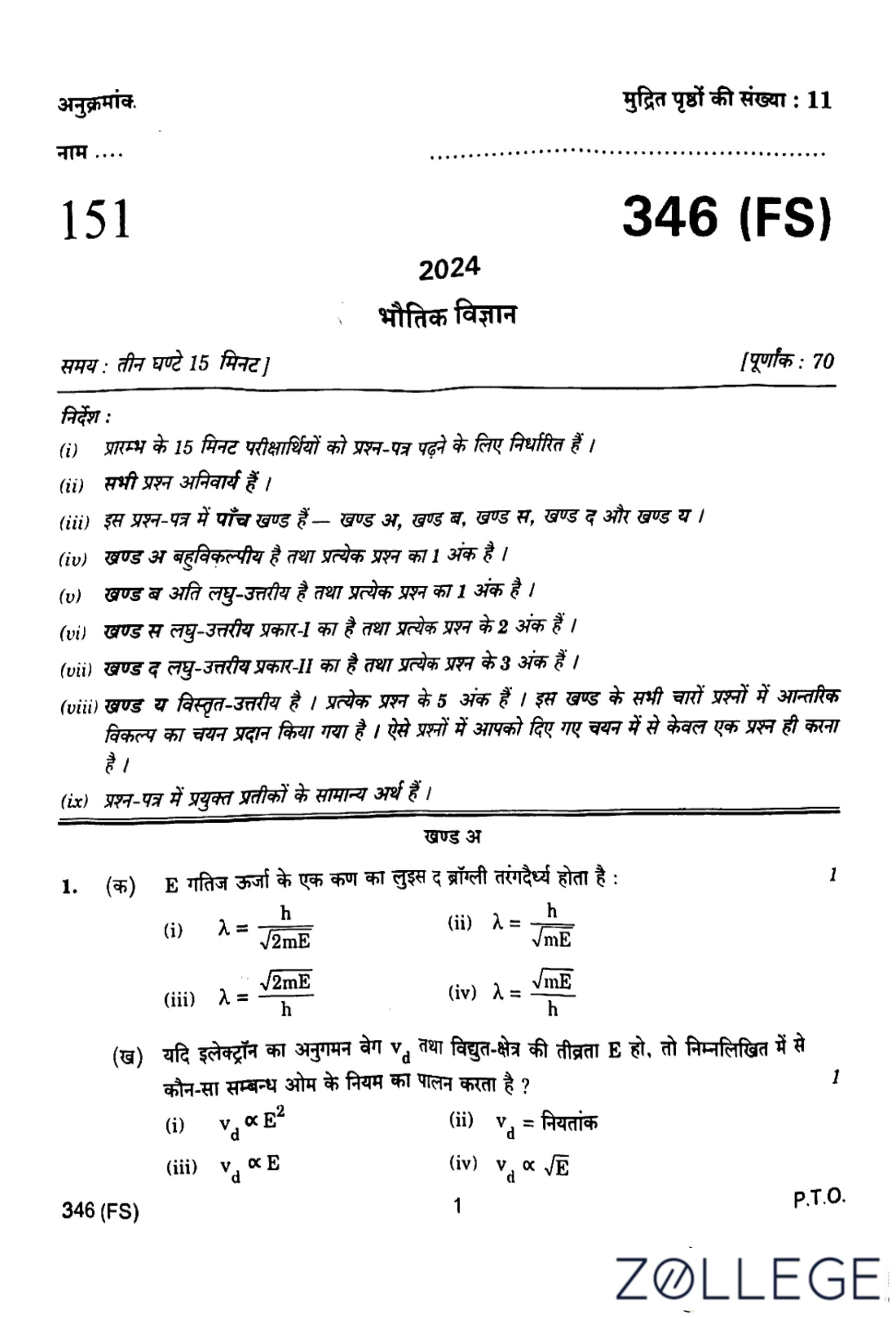
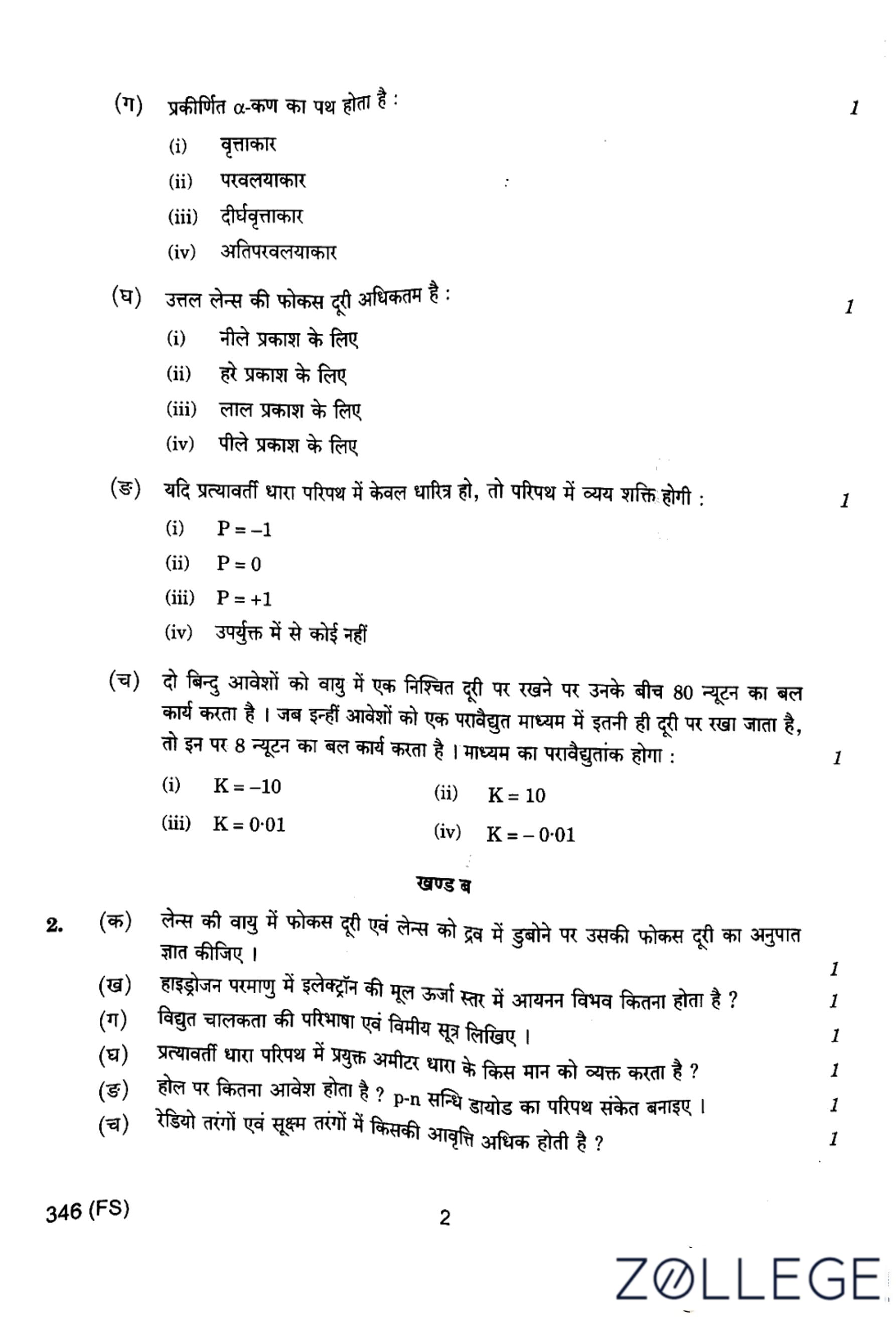
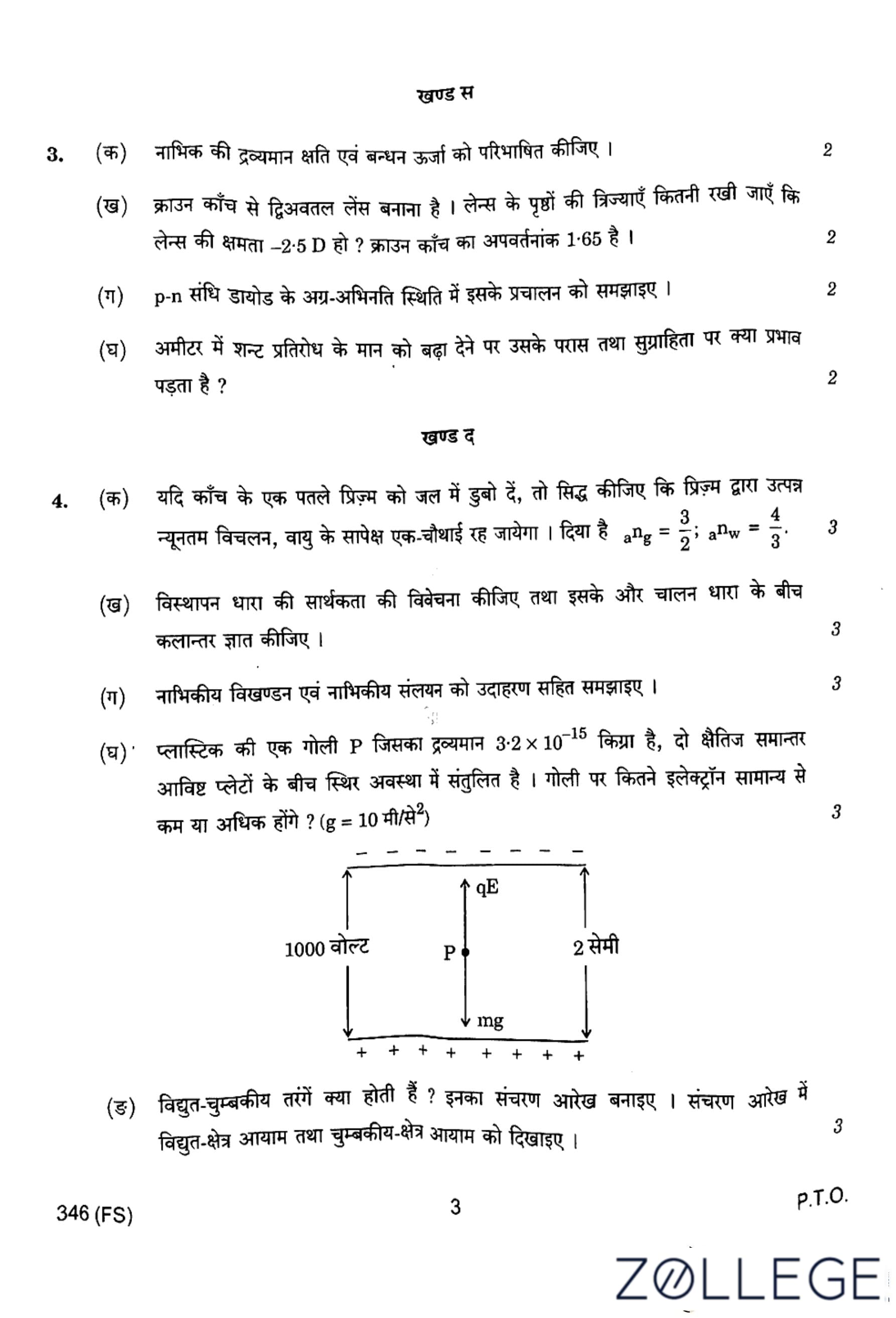
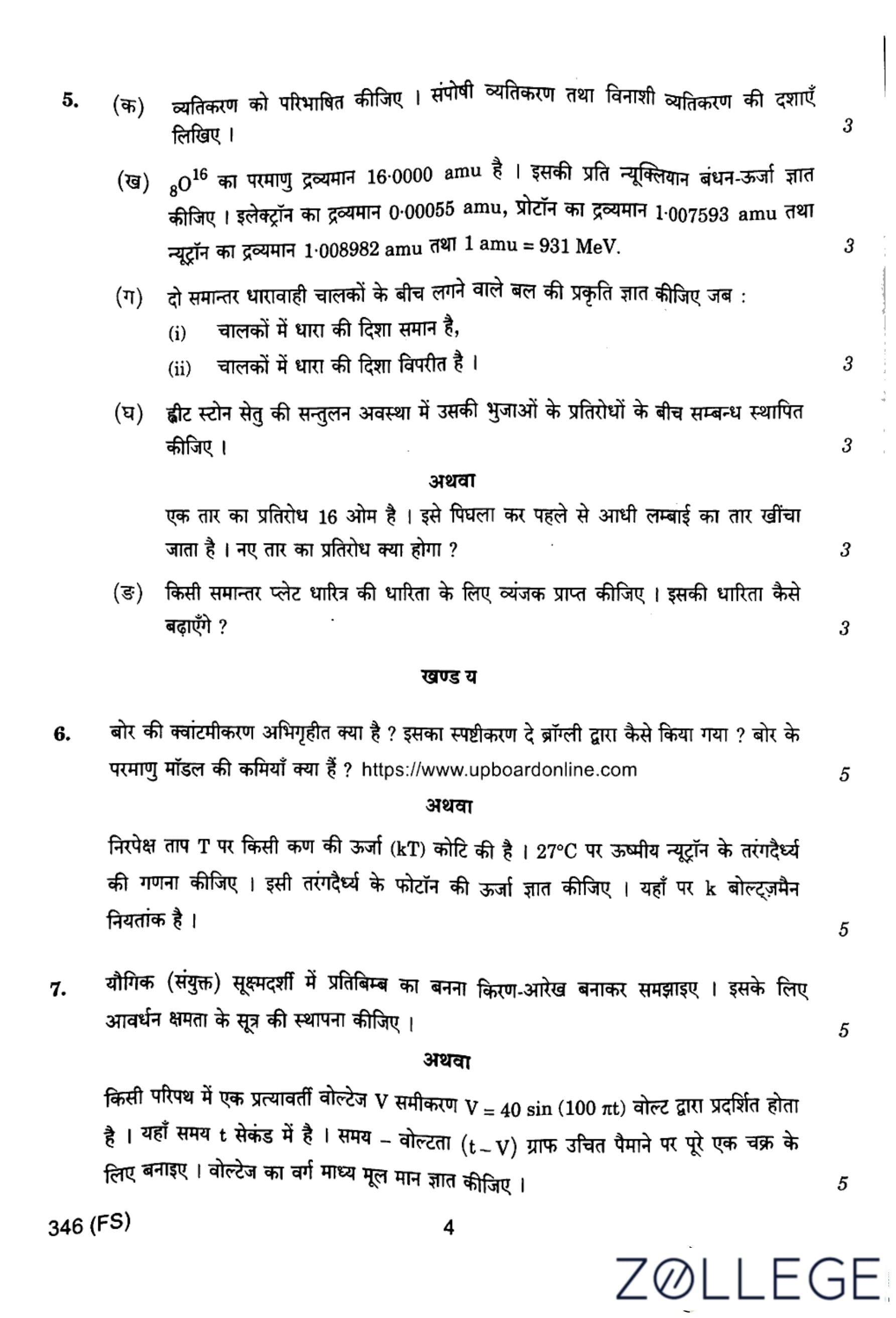
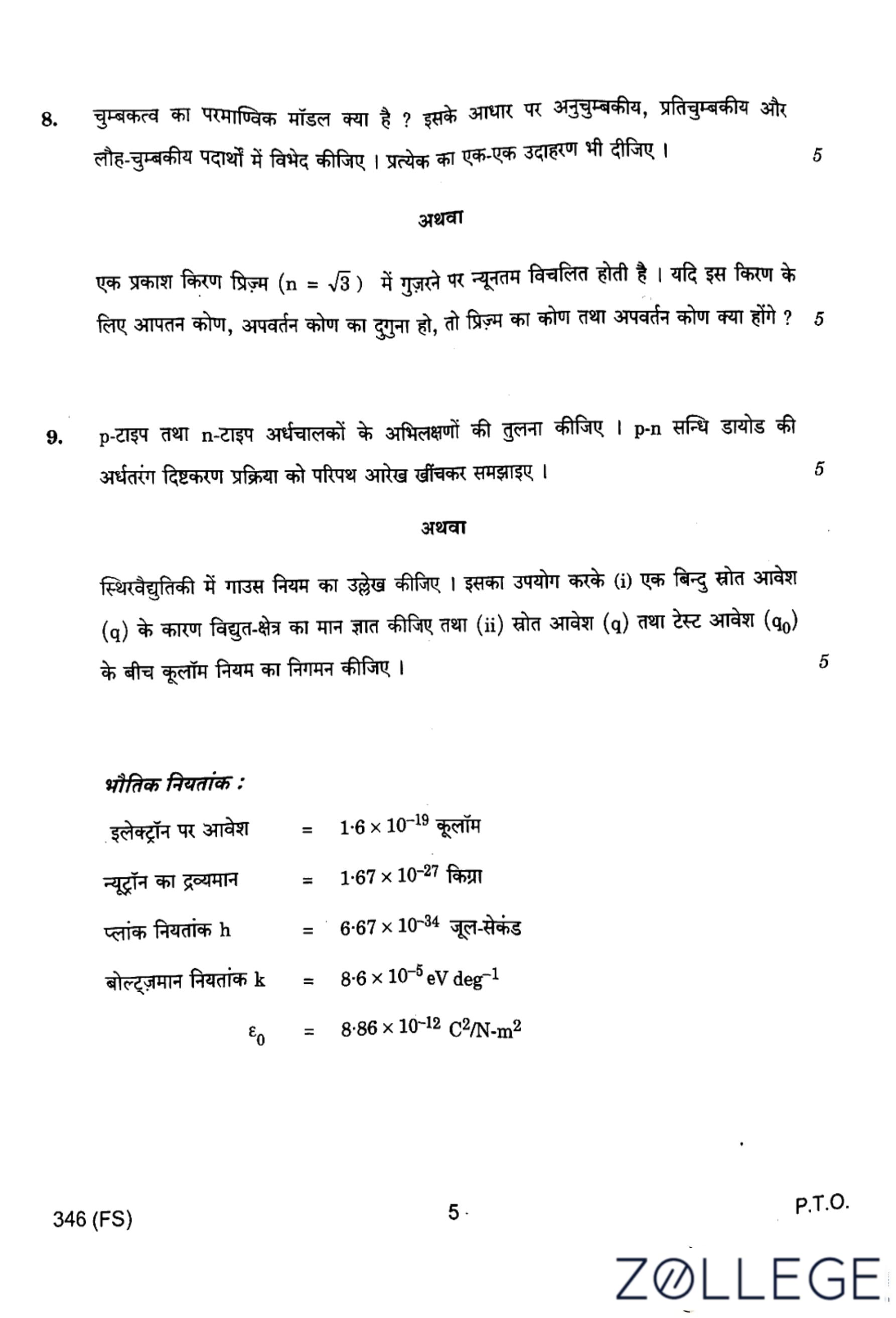
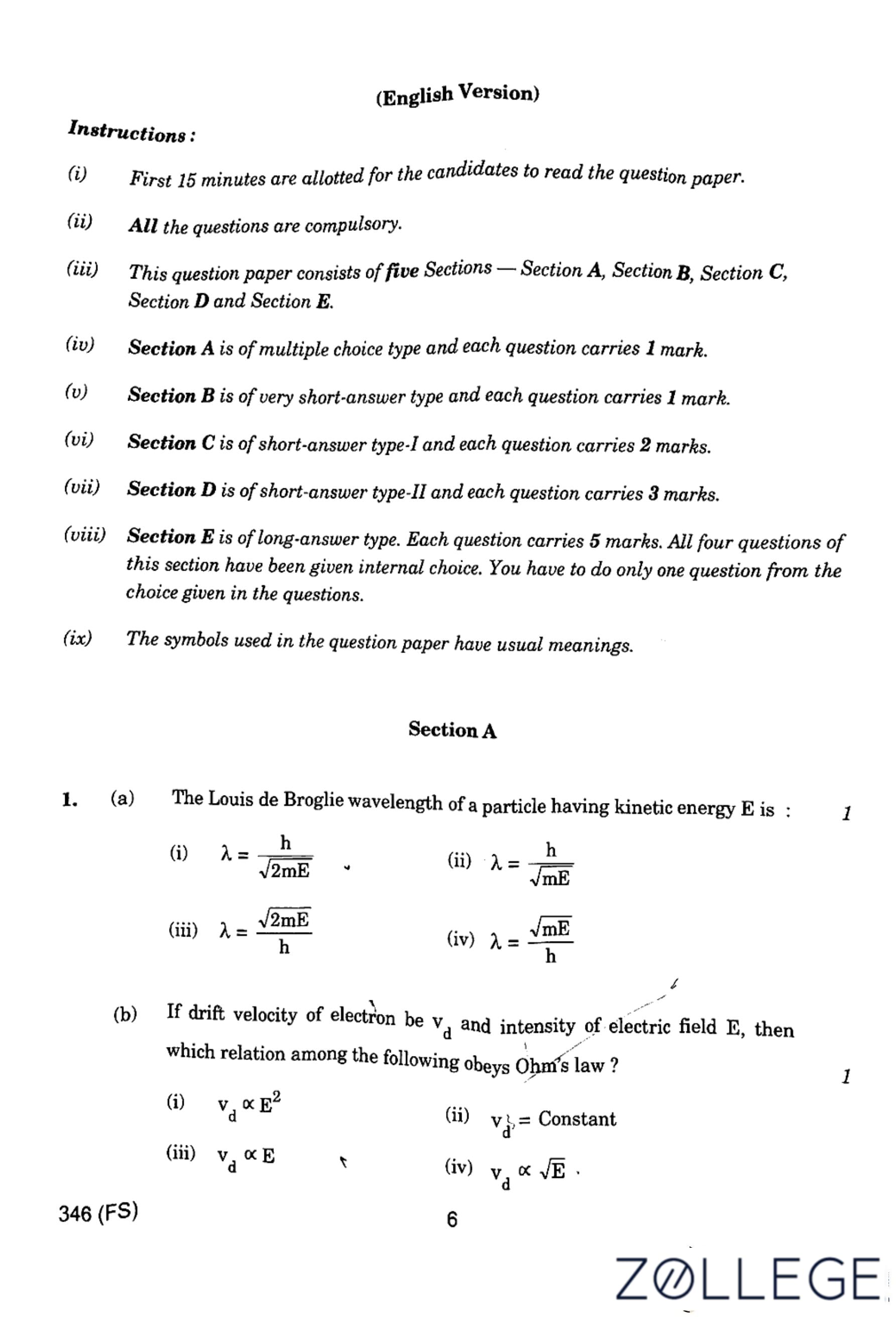

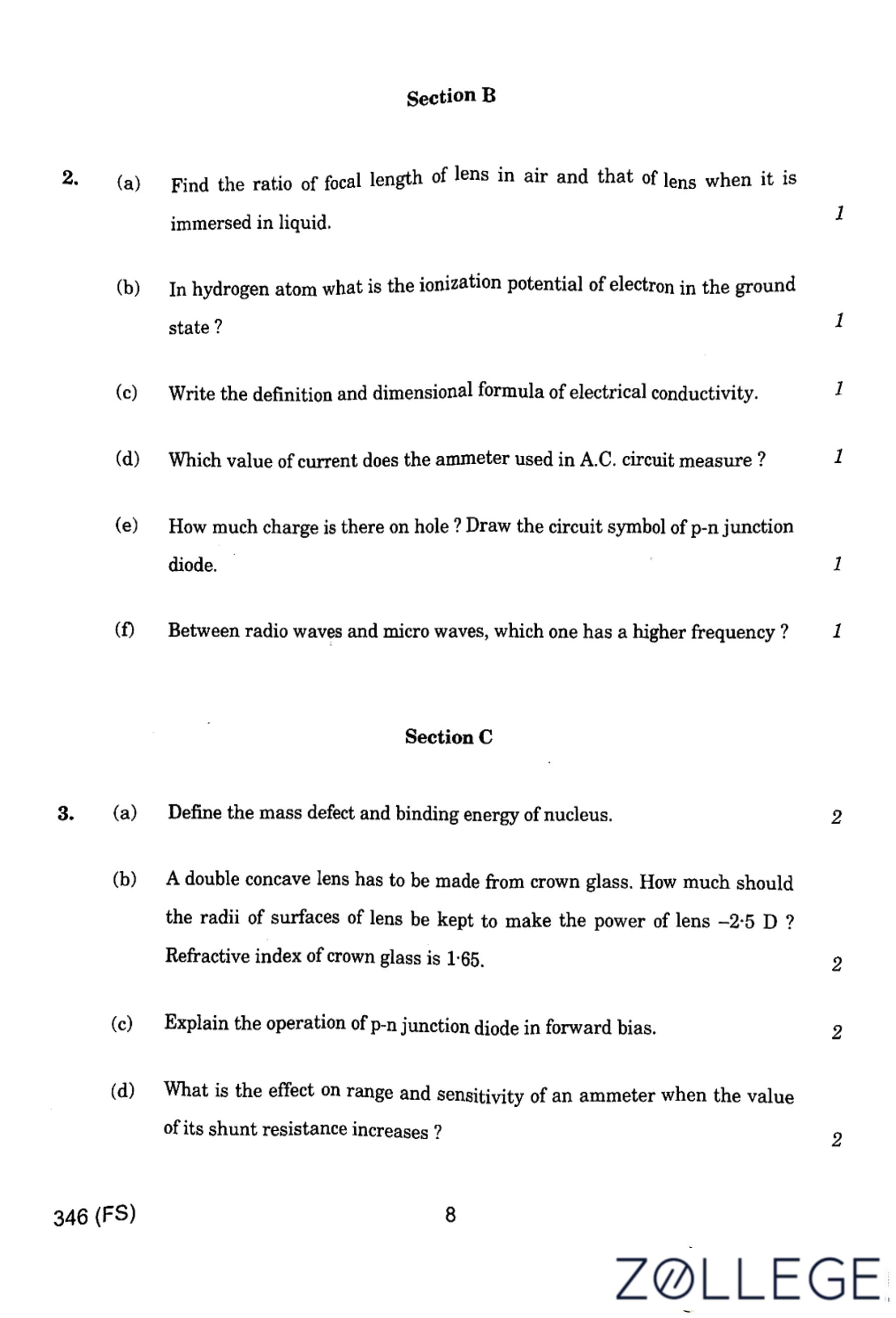

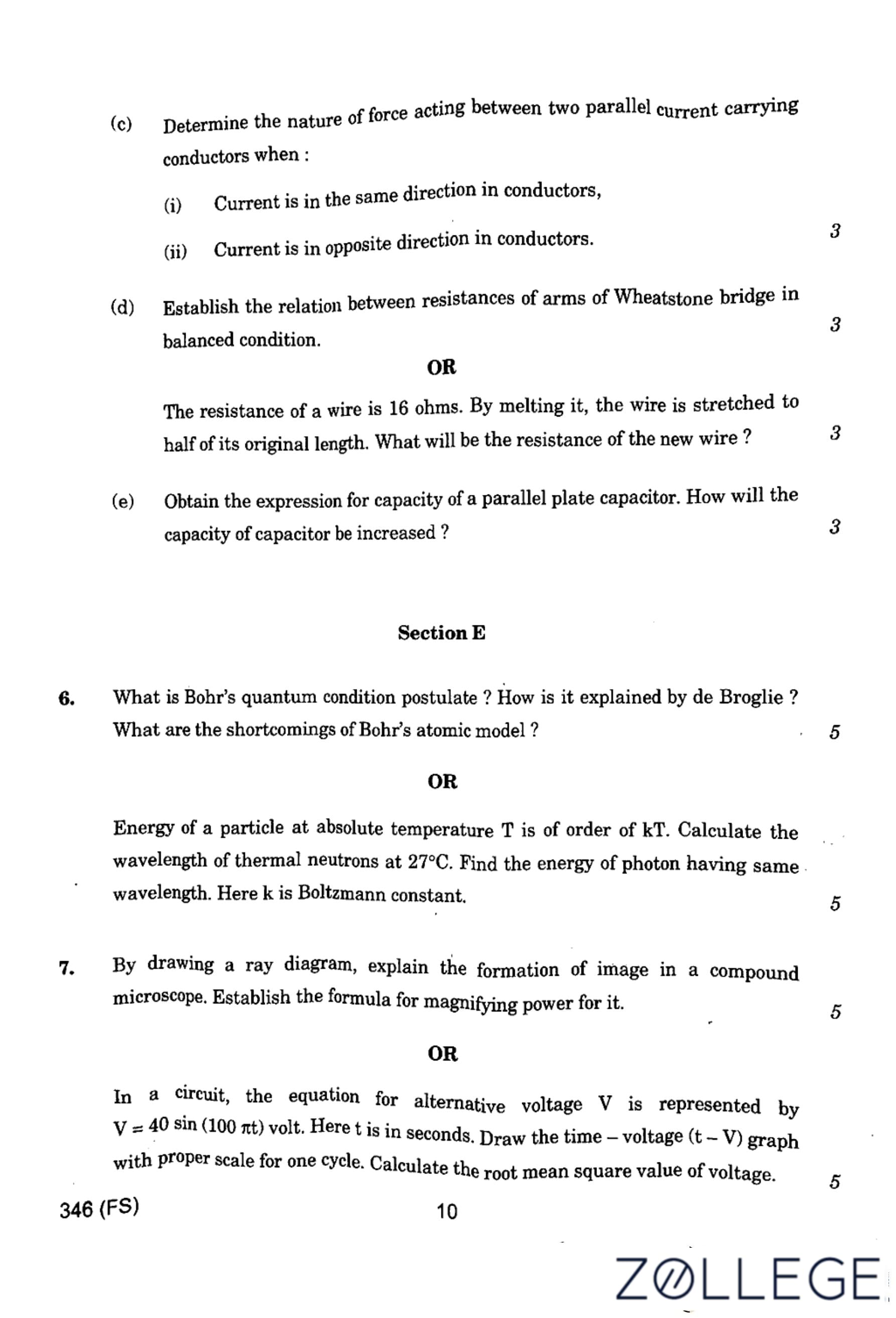
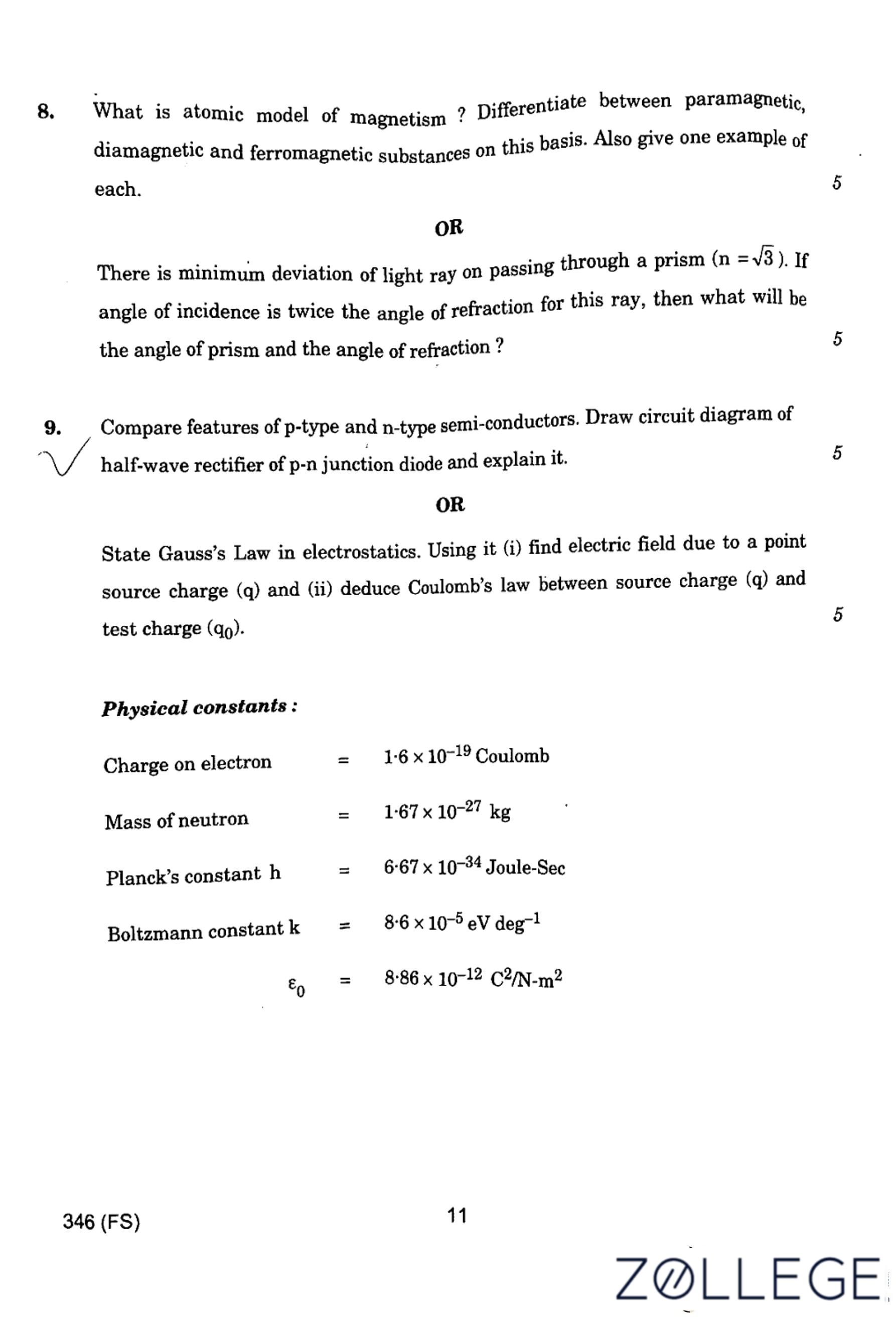



Comments